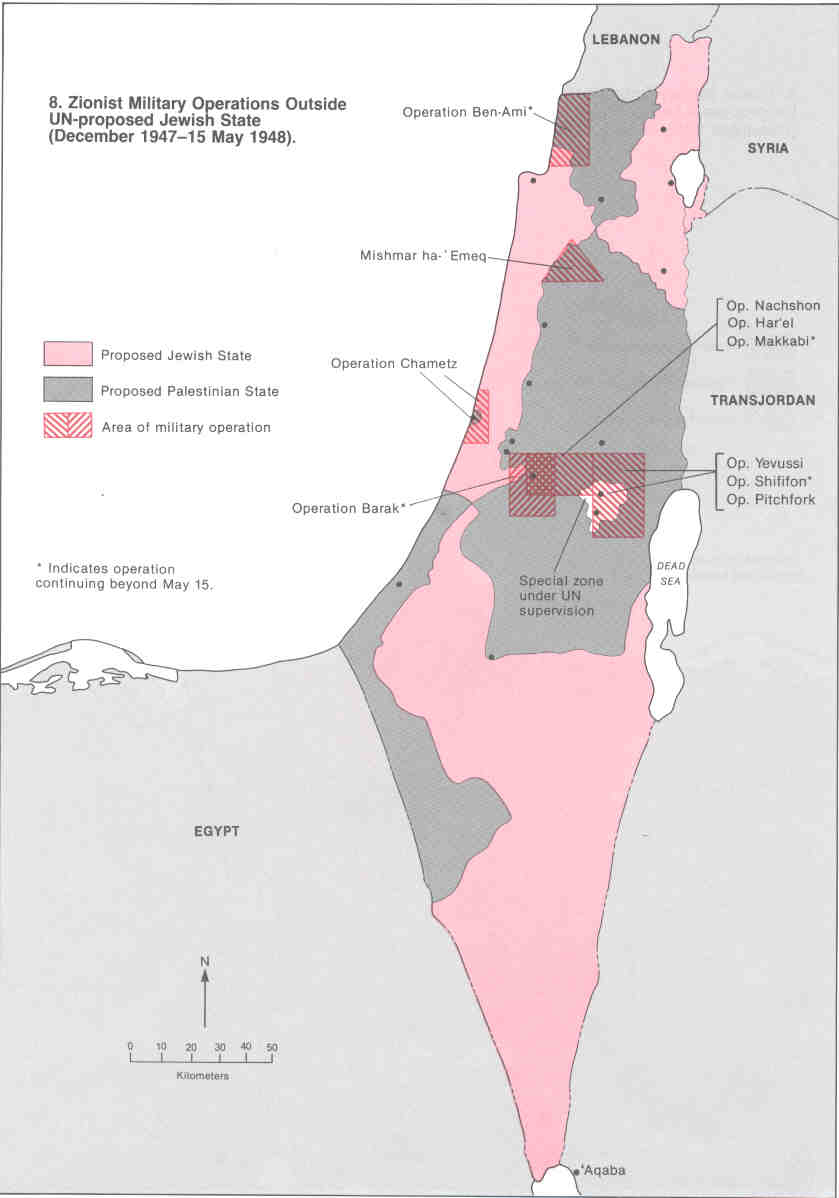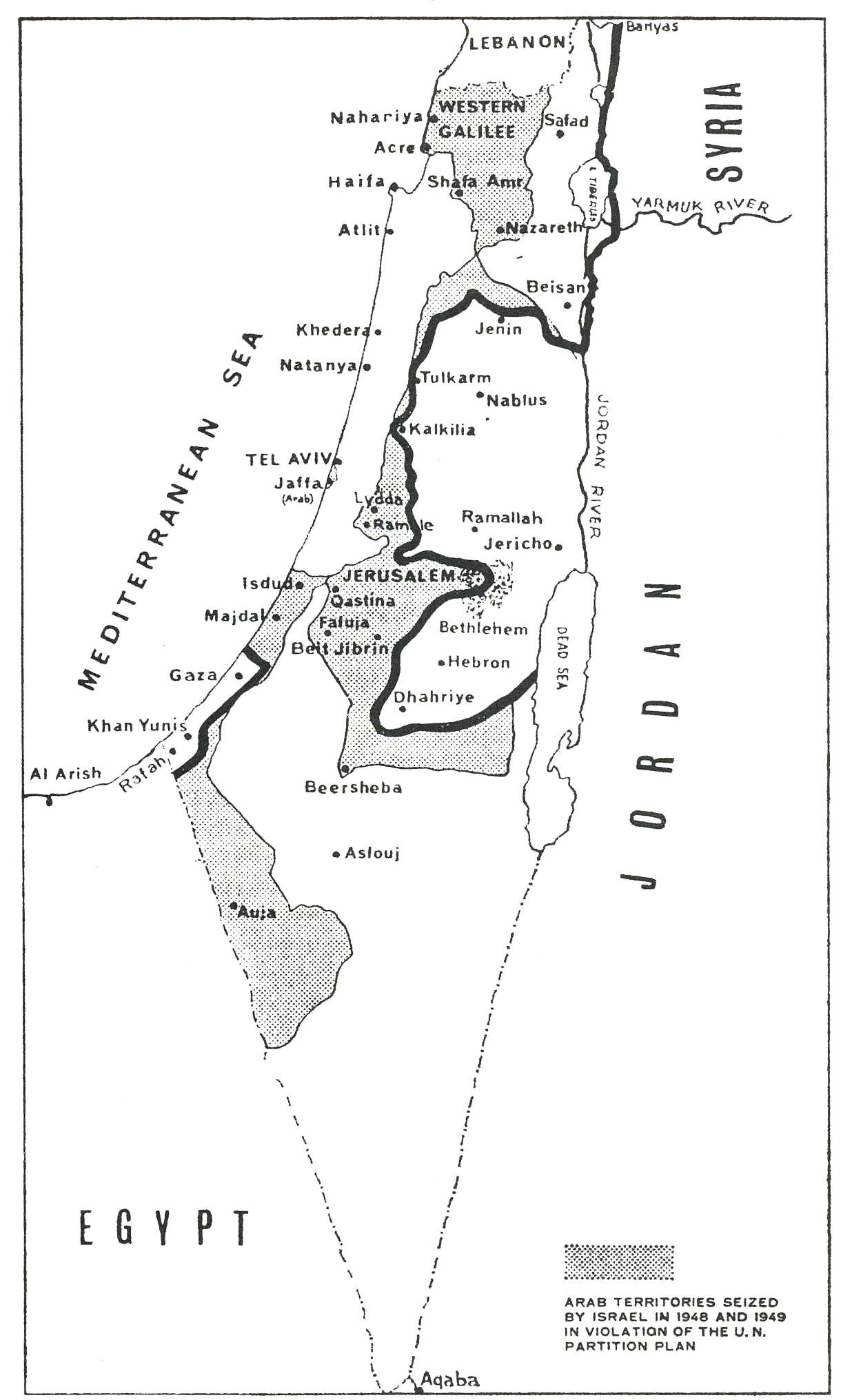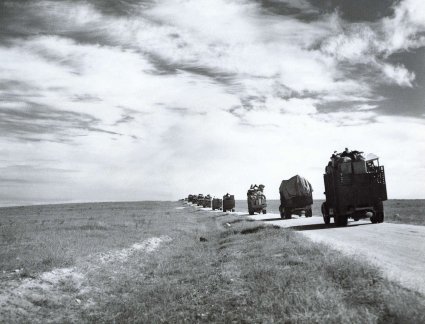Plan Dalet and The NAKBA

Zionist operations outside the UN designated Jewish part of Palestine
Terrorism and terrorist operations were first introduced in Palestine by the Jewish underground to demoralise the British Army. These operations were carried out by the same Jewish elements trained by the British Army in North Africa as an adjunct to their WWII effort against the Nazis. By 1939 this Jewish auxiliary force numbered 20,000 strong.
This force, which was given the innocent-sounding name of 'The Jewish Settlement Force', employed terrorist tactics against British troops supplemented by terrorist operations carried out by their underground brethren throwing bombs in bus stops, cafes and marketplaces. These bombs were hidden in milk cans, fruit baskets and similar daily objects. Parallel with these operations, terrorist innovations included the kidnapping of British officers, whipping them, hanging them and booby-trapping their hanging bodies which made for shocking headlines back home in the UK.
In the last year of the British Mandate, the ratio of British officers dead to Jewish terrorists killed was 4 to 1 - a very high ratio even in today's standards. No wonder Britain wanted out of Palestine.
The Zionist plan to transfer Palestinians out of their land was headed by no lesser character than David Ben-Gurion himself. He plotted these schemes in his own home aided by a small ad hoc group of people referred to as The Consultancy. Its aim was to plot and carry out the disposession of the Palestinian people.
As early as February 1947, when the British Cabinet voted to pull out of Mandatory Palestine, the Zionist leadership knew that the road ahead was clear for their aims to be achieved. The Consultancy first met (according to Ben-Gurion's diary) on 18 June 1947 and continued to meet regularly during the months leading to October 1947 when it transpired that the UN will now issue its Resolution 181 to partition the land of Palestine.
The Zionist leadership and its Consultancy group also knew that the Palestinians and the Arab leadership in general would reject the Partition Resolution. The Consultancy realised that this would be the time not only to forge forward their plan to clear the Palestinian population from the UN-designated future Jewish state, but also from the areas accorded to the Arab state.
Prior to 1947, the Zionist agenda concentrated on building a political, ideological, cultural and economic enclave within historic Palestine. Now, during these crucial months leading to UN Resolution 181, it was decided that the time has come to translate these ideologies into realities on the ground.
Just before the UN voted to partition Palestine in November 1947, Ben-Gurion secretly mobilised Jewish groups inside and outside Palestine and dispatched them to Europe to purchase massive quantities of arms for the next phase: the military plan to conquer as many Palestinian villages and to expel their inhabitants.
Their plan was called Plan D better known as Plan Dalet, (Dalet being the fourth letter in the Hebrew alphabet) which was launched nearly six weeks prior to the end of the British Mandate in Palestine. It is worth noting that Plan D had been preceeded by Plan A (February 1945), Plan B (May 1947) and Plan C (November 1947) - all with the single intention of the ethnic cleansing of Palestine.
March 1948: two months before the so-called Declaration of Independence, the Zionist leadership gathered in Tel Aviv and agreed to put Plan D into action. Over 13 military underground operations were carried out (according to The History of the Palmach archives released in full in 1972) before the Arab forces entered the areas allotted to the Palestinians by the UN in their Partition Plan. Both Menachem Begin and David Ben-Gurion wrote extensively about their underground military campaigns to cleanse Palestinian villages of their indigenous inhabitants.At the onset of Plan Dalet in April 1948, Jewish immigration into Palestine had exceeded 600,000 (compared to 56,000 in 1917). With that many immigrants, the Zionist leadership was able to deploy an army of 65,000 well armed and well trained soldiers, (a number that increased to 120,000 in early 1949, amounting to 20% of the total Jewish population of the newly declared State). This is an unprecendented percentage when compared to 1%-2% for a typical country at the time.
As the execution of Plan Dalet proceeded with clockwork precision, the Haganah created a 'Committee for Arab Properties in Villages' the purpose of which was to register and take possession of all Palestinian properties in the villages the Zionist forces had conquered. Similar committees were established in major Palestinian cities like Haifa, Safad, Yafa and Tabariyah.
All this was taking place BEFORE Israel was even born!
When the Zionist leadership unilaterally declared their so-called state of Israel on 15 May 1948, they purposefully avoided declaring its boundaries to keep their options open for future expansion. That expansion has since covered the whole of historic Palestine. Soon after 15 May 1948, the Arab armies entered Palestine in an attempt to defend Palestinian civilians expelled from their homes and villages in what became Israel. The Jewish forces, better equipped and more organised, swept through the part of Palestine allocated to the Palestinians in UN Resolution 181, and grabbed more land including the Galilee, and west Jerusalem part of the International Zone called Corpus Separatum under UNRes 181 ( see later sections).
At the end of Plan Dalet, the Haganah set up "The Committee For Abandoned Arab Property" – The CFAAP – which was entrusted with the disposal of all Arab possessions into Yishuv hands. The intention was to obliterate any sign of ‘life’ in the abandoned Palestinian homes and villages.
By June 1948, approximately 370,000 Palestinians were expelled from their homes, and by the end of that year the number was nearer 780,000. Josef Weitz declared, at a cabinet meeting chaired by Ben-Gurion on 18 August 1948, that 286 villages had been cleared or evacuated and about 3 million dunums had been left behind by their Palestinian owners as they fled the Zionist terror. The last of the villages to be cleared was Al-Majdal (later renamed Ashkelon by Israel).
Within 6 months, Zionist terrorist organizations went on a rampage expelling and murdering Palestinians and destroying their homes and villages. They expelled 452,780 Palestinians men, women and children from the areas allocated to the Jews in the Partition Plan, and a further 347,220 were uprooted from areas beyond the allocated boundaries. All in all, a total of 800,000 Palestinians were expelled from their homes, 530 of their villages destroyed and 11 of their urban neighbourhoods were emptied. Massacres, such as at Deir Yaseen, spread fear and terror in the hearts of Palestinian families and forced them to take flight.
By November 1948, Israel completed the occupation of the most fertile and populated areas of Palestine, and by December, it issued "the Emergency Regulations Relative to Property of Absentees". This was followed by yet another discrimanatory law called the "Law of The Acquisition of Absentee Property", (Absentees Property Law, 4L ST. Israel 68, 1949-1950). This law effectively classified all Palestinian refugees as "absent" and immediately transferred the control of their private properties to a Custodian who has the sole discretion to determine whether any Arab Palestinian is "absent' and to confiscate his/her property. This arbitrary definition was applied, not only to those who were expelled beyond the 'Armistice Line', but was extended to Palestinians who remianed in Israel.
Those who remained in Israel, but were not in the specified place on a particular date (i.e., they may have been in the next village or away for a day or so), were declared "absent". Since these people, thus declared, eventually became Israeli citizens, they were dubbed as "present absentees", an ironical but accurate description of this Israeli fictitious legislation.

The Palestinian Exodus was one of the largest in post war history, and the reasons for it were confirmed by IDF intelligence as follows: Haganah operations (55%), operations by Irgun (15%) and whispering campaigns of psychological warfare (14%).
Chaim Weizmann later commented that this Palestinian Exodus had been “a miraculous clearing of the land: the miraculous simplification of Israel’s task”.

And so it was: the Zionist dream of transfer and the ethnic cleansing of Palestine came to fruition with the Palestinian Exodus of 1948 when more than 80% of the inhabitants of what became Israel were expelled and became refugees until this day. Some 140,000-150,000 Palestinians had remained behind in what became Israel and were allowed to stay. The borders of this new state, remain unrecognised and unofficial, since they have been expanding through military conquest from the 55.5% of Mandatory Palestine (under the Partition Plan of November 1947) to 78% of historic Palestine (at the time of the 1949 Armistice Agreement). Of course, the conquests continued in 1967 when Israel swept through and occupied the whole of historic Palestine.